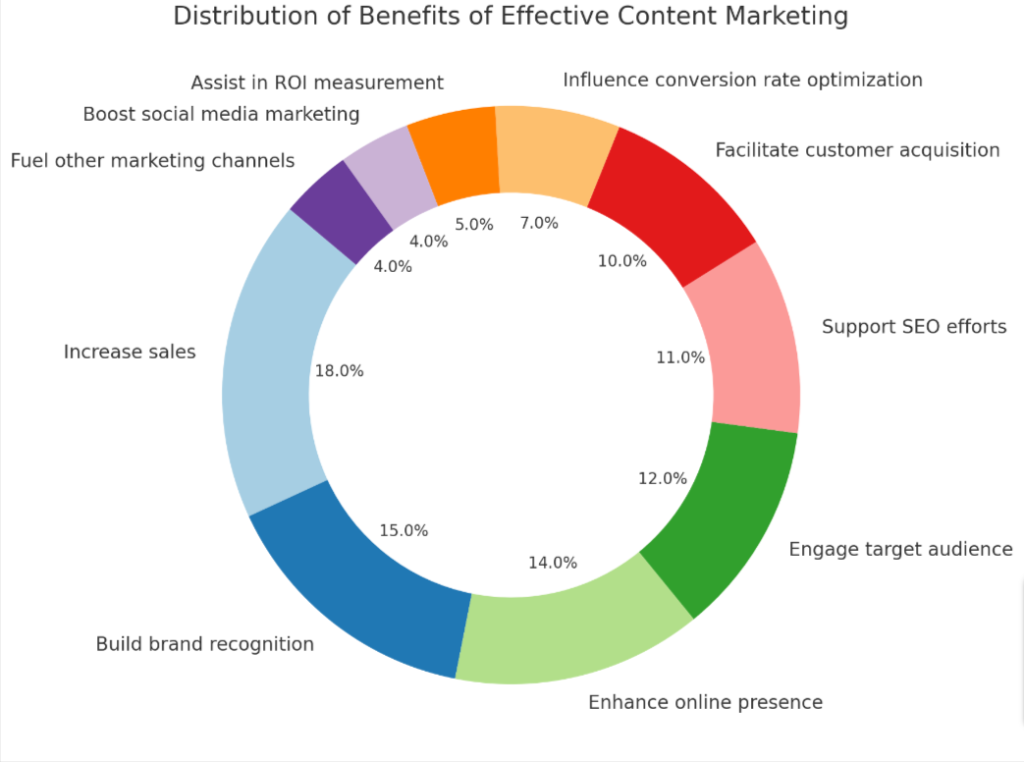Leveraging Content Marketing: Pathways to Prosperity
Are you struggling to fill your wallet while sinking in the sea of digital marketing? Believe it or not, businesses that prioritize strategic content marketing obtain nearly six times higher conversion rates than their competitors.
This blog will serve as a roadmap for increasing sales and making money using effective content marketing strategies. Ready to turn words into wealth?.
Key Takeaways
- Content marketing is a strategic approach to creating and distributing valuable content that attracts and engages your target audience.
- Effective content marketing can increase sales, build brand recognition, enhance online presence, engage the target audience, support SEO efforts, facilitate customer acquisition, influence conversion rate optimization, assist in ROI measurement, boost social media marketing, and fuel other marketing channels.
- To create a successful content marketing strategy: set realistic goals, create a budget, identify your target audience, focus on producing high-quality content, and track metrics.
- Tips for effective content creation include staying true to your brand’s identity and values across all channels; being relevant,
What is Content Marketing?
Content marketing is a strategic approach to creating and distributing valuable, relevant, and consistent content to attract and engage a clearly defined audience.
Definition
Content marketing is a strategic approach focused on creating, distributing, and sharing valuable content to attract a defined target audience. The goal is not just to generate interest but also drive profitable customer action.
It’s about delivering content that your audience will appreciate, in various forms such as blog posts, social media updates or videos. This method aims to build strong relationships with potential customers by providing them with high-quality material on a regular basis.
Remember: Effective content marketing is never overly promotional; it always prioritizes the needs and interests of the audience over hard sells or product pitches.
Benefits
Content marketing carries a host of benefits designed to boost both your online presence and your wallet.
- Increases Sales: A well-planned content marketing strategy drives up product interest and consequently, sales.
- Builds Brand Recognition: Consistent, engaging content helps create a formidable image for your brand among potential customers.
- Enhances Online Presence: It aids in developing a strong digital footprint which forms an essential part of digital marketing.
- Engages Target Audience: By crafting valuable content tailored to the audience’s interests, you’ll increase engagement and foster brand loyalty.
- Supports SEO Efforts: Strategic use of keywords helps improve your website’s visibility on search engines like Google, increasing traffic.
- Facilitates Customer Acquisition: High-quality content attracts new customers by providing solutions to their queries or needs.
- Influences Conversion Rate Optimization: By moving customers smoothly through the sales funnel with engaging content, it increases the chances of conversions.
- Assists in ROI Measurement: Tracking metrics like user engagement and lead generation lets you gauge the effectiveness and return on investment of your marketing strategy.
- Boosts Social Media Marketing: Content forms the backbone of any successful social media campaign, as it fosters audience interaction and shares.
- Fuels Other Marketing Channels: One comprehensive content pillar can be repurposed across various channels, optimizing resources while keeping messaging consistent.

Different types (blog articles, newsletters, social media posts, videos, etc.)
In the world of content marketing, a variety of mediums can be used to reach your target audience. These include:
- Blog Articles: This type provides an in-depth look at topics relevant to your brand and industry. It increases online presence and fuels SEO.
- Newsletters: Regular newsletters engage with loyal customers, providing them updates on products or services and maintaining a continued relationship.
- Social Media Posts: Quick updates or promotions on platforms like Instagram, Facebook, or Twitter keep your brand fresh in the minds of followers.
- Videos: Video content offers an engaging way to showcase product features or explain complex concepts. This helps with customer acquisition and lead generation.
- Infographics: A visual portrayal of data or information makes consumption easier for audiences, boosting inbound marketing efforts.
- Podcasts: Audio content lets your brand’s voice literally be heard by audiences, creating a personal connection and enhancing branding efforts.
- eBooks/Whitepapers: Detailed guides accentuate your industry authority while driving lead generation through gated access.
- Webinars/Virtual Events: Online events provide real-time engagement opportunities with audiences, increasing customer acquisition rates.
Creating a Successful Content Marketing Strategy
To create a successful content marketing strategy, start by setting realistic goals, creating a budget, identifying your target audience, and focusing on producing high-quality content.
Setting realistic goals
Setting realistic goals is a crucial step in creating a successful content marketing strategy. By setting clear and achievable objectives, you can measure your progress, track the effectiveness of your efforts, and make adjustments as needed.
Whether your goal is to increase sales, build a stronger online presence, or engage with your target audience, it’s important to define specific metrics that align with these objectives.
Setting realistic goals will help you stay focused and motivated throughout your content marketing journey while ensuring that you are making measurable progress towards achieving tangible results.
Creating a budget
To create a successful content marketing strategy, it is important to allocate a budget. This will help you determine how many resources you can allocate to different aspects of your strategy, such as content creation, promotion, and audience engagement.
By setting aside a specific amount for each area, you will be able to ensure that you are investing in the right places and maximizing your ROI. Additionally, having a budget allows you to track your spending and make adjustments if necessary.
With careful planning and budgeting, you can effectively fuel your content marketing efforts and see increased sales and brand building results.
Identifying target audience
Identifying your target audience is a crucial step in creating an effective content marketing strategy. By understanding who your ideal customers are, you can tailor your content specifically to their needs and interests.
Start by researching demographics such as age, gender, location, and income level. Then dig deeper into psychographics like interests, values, attitudes, and behaviors. This information will help you create content that resonates with your target audience and drives engagement and conversions.
Focusing on quality
Creating high-quality content is essential for a successful content marketing strategy. By focusing on quality, you can effectively engage your target audience and build trust with them.

High-quality content is relevant, authentic, and useful to your audience. It stays true to your brand’s voice and values while providing valuable information or entertainment. Whether it’s blog articles, social media posts, videos, or newsletters, each piece of content should be well-crafted and tailored to meet the needs of your audience.
By consistently delivering high-quality content, you can establish yourself as an authoritative source in your industry and attract more customers to fill your wallet.
Tracking metrics
Tracking metrics is a crucial step in any content marketing strategy. By monitoring and analyzing key data points, you can gain valuable insights into the effectiveness of your content and make informed decisions to improve your results.
Metrics such as website traffic, engagement rates, conversion rates, and social media reach provide concrete evidence of how well your content is resonating with your target audience.
This allows you to identify what’s working and what’s not, so you can fine-tune your approach and maximize the impact of your content efforts. Don’t overlook the power of tracking metrics – it’s an essential tool for optimizing your content marketing success.
Tips for Effective Content Creation
Stay true to your brand by maintaining consistency in tone, style, and messaging across all your content channels.
Staying true to brand
Staying true to your brand is essential in content marketing. Consistency in messaging, tone, and visuals helps establish a strong and recognizable identity for your business. By staying true to your brand, you build trust and loyalty with your audience.
Whether you’re creating blog articles, social media posts, or videos, make sure they reflect the values and personality of your brand. This will ensure that every piece of content resonates with your target audience and strengthens your overall brand presence online.
Being relevant, authentic, and useful
Creating relevant, authentic, and useful content is crucial for a successful content marketing strategy. By understanding the needs and interests of your target audience, you can tailor your content to provide valuable information that resonates with them.
Authenticity helps build trust and credibility with your audience, making them more likely to engage with your brand. Focus on delivering content that is not only informative but also practical and actionable, providing tangible benefits or solutions to their problems.
Being relevant means staying up-to-date with industry trends and current events, ensuring that your content remains timely and addresses the issues that matter most to your audience.
Customizing for each channel
Customizing your content for each channel is crucial to maximize its effectiveness. Different social media platforms and channels have varying formats, requirements, and user expectations.
By tailoring your content specifically for each channel, you can ensure that it resonates with the target audience and drives engagement. For example, a video might work well on YouTube or Instagram but may not be as effective on LinkedIn.
Similarly, shorter and punchier posts tend to perform better on Twitter compared to longer articles that are better suited for blogs or newsletters. Take the time to understand the unique qualities of each channel and adapt your content accordingly to make the most impact.

Utilizing all types of content
Utilizing all types of content is essential for a successful content marketing strategy. By diversifying your content, such as blog articles, newsletters, social media posts, and videos, you can reach a wider audience and keep them engaged.
Each type of content serves a different purpose and caters to different preferences. Blog articles provide in-depth information, newsletters allow for direct communication with subscribers, social media posts encourage interaction and sharing, and videos offer visual storytelling.
By incorporating all these forms of content into your strategy, you can effectively deliver your message and connect with your target audience on multiple platforms.
To maximize the impact of utilizing all types of content in your strategy:
– Use blog articles to establish yourself as an expert in your industry
– Send out engaging newsletters to build relationships with your audience
Incorporating keywords for SEO
Incorporating keywords for SEO is a crucial aspect of content creation. By using relevant and targeted keywords throughout your content, you can optimize your website’s visibility on search engines.
This helps potential customers find your business more easily when they search for products or services related to what you offer. It’s important to conduct keyword research to identify the most valuable keywords for your industry, and then strategically place them in your content.
This will not only improve your search engine rankings but also attract organic traffic to your website and increase the chances of conversions.
Tools and Examples of Successful Content Marketing
You’ll learn about useful tools for content creation and discover real-life examples of successful content marketing campaigns.
Useful tools for content creation
To create engaging content that fills your wallet, you’ll need to utilize some helpful tools for content creation:
- Grammarly: This tool helps you write error-free content by checking for grammar and spelling mistakes.
- Canva: Create stunning visuals and graphics for your content easily with this user-friendly design tool.
- BuzzSumo: Find popular topics and trending content in your industry to stay ahead of the curve.
- Google Trends: Discover what people are searching for and use this data to create relevant and valuable content.
- Hemingway Editor: Simplify your writing and ensure clarity by using this tool that highlights complex sentences and suggests improvements.
- Yoast SEO: Optimize your content for search engines with this plugin that provides real-time suggestions for improving SEO.
- CoSchedule Headline Analyzer: Craft attention-grabbing headlines that drive clicks and engagement with this helpful tool.
Examples of successful content marketing campaigns
Successful content marketing campaigns have proven to be highly effective in increasing sales and creating a strong online presence. Here are some examples of how brands have mastered the art of content marketing:
- Red Bull’s “Stratos” Campaign: Red Bull created a captivating campaign around Felix Baumgartner’s record-breaking skydive from space. The brand produced engaging videos and live-streamed the event, capturing millions of viewers and generating widespread buzz.
- Dollar Shave Club’s “Our Blades Are F***ing Great” Video: This viral video kick-started Dollar Shave Club’s success story. With humor and a clear value proposition, the brand managed to resonate with its target audience, leading to a significant increase in subscriptions.
- Airbnb’s “Airbnb Citizen” Blog: Airbnb launched a blog called “Airbnb Citizen,” where they share stories about hosts making a positive impact on their communities. This compelling content showcases Airbnb’s values, builds trust with potential users, and humanizes the brand.
- Patagonia’s “Worn Wear” Initiative: Patagonia created an online platform called “Worn Wear,” where customers can buy and sell used Patagonia products. This campaign not only promotes sustainability but also strengthens customer loyalty by showcasing the durability and longevity of their products.
- Buffer’s Transparent Social Media Strategy: Buffer is known for its transparent approach to social media marketing. They openly share data, experiments, and insights through their blog and social media channels. This transparency has helped build trust with followers and position Buffer as an authority in their field.
Analyzing and learning from competitors
To become a content marketing master, it’s important to analyze and learn from your competitors. Here are some ways you can gain valuable insights from them:

- Study their content: Take the time to read and analyze the content your competitors are creating. Look for patterns in their topics, writing style, and formats.
- Identify their target audience: Pay attention to who their content is aimed at. Analyze their language, tone, and messaging to understand how they attract and engage with their target audience.
- Assess their content distribution channels: Take note of which channels your competitors are using to distribute their content. Are they focusing more on social media or email newsletters? This information can help you determine where your own content should be promoted.
- Monitor their engagement metrics: Keep an eye on how well-received your competitors’ content is by looking at likes, shares, comments, or any other engagement metrics available. This can give you an indication of what resonates with your shared audience.
- Look for gaps in their strategy: Identify areas where your competitors may be lacking in terms of content quality or consistency. Use this insight as an opportunity to provide a unique value proposition that sets you apart from them.
Conclusion
Content marketing has the power to make a real impact on your bottom line. By setting goals, targeting your audience, and creating high-quality content, you can drive sales and build a strong online presence.
So, take the time to develop a solid content marketing strategy and watch as it fills your wallet with success.

